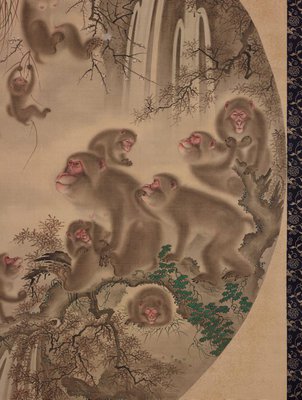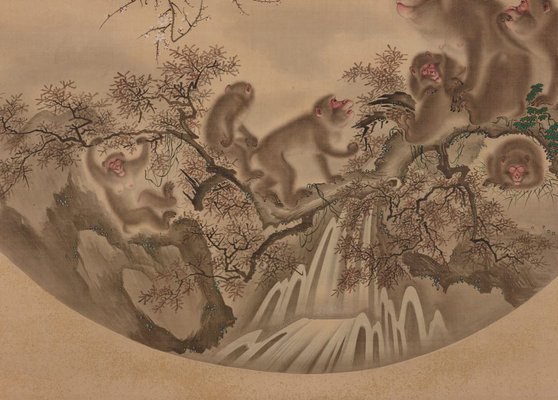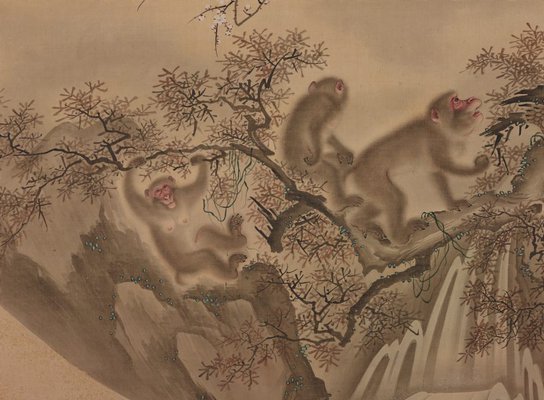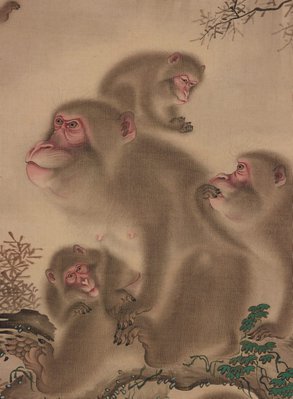








-
Details
- Place where the work was made
-
Japan
- Period
- Edo (Tokugawa) period 1615 - 1868 → Japan
- Date
- late 18th century-early 19th century
- Media categories
- Scroll , Painting
- Materials used
- hanging scroll: ink and colours on silk
- Dimensions
- image: 110.0 x 86.0cm; overall: 210.0 x 104.0cm
- Signature & date
Signed l.r.
- Credit
- Purchased with funds provided by the Yasuko Myer Bequest and theAsian Collection Benefactors 2016
- Location
- Not on display
- Accession number
- 306.2016
- Copyright
- Artist information
-
Mori Sosen
Works in the collection
- Share
-
-
About
Mori Sosen (1747-1821) was active in Osaka during the Edo period. He first studied Kanō painting and then became part of the Shijō School, whose style advocated Western inspired realism.
By the time Mori Sosen was 61 years old he changed the first character in his name (so) to mean ‘monkey’. Rather than the traditional practice of copying the paintings of master painters to perfect technique (in this instance usually original paintings of animals by Chinese artists), Mori Sosen is said to have lived in the mountains to learn how to depict animals in a more compelling and realistic manner. Contemporaries such as Maruyama Ōkyo (whose work Cranes, c.1770-1772 is in the AGNSW Collection) were at this time also creating works from sketches of real life.
The Dutch orientalist, Robert van Gulik (1910-1967), had designated Mori Sosen “undisputed master” for his skilful depiction of the animal. It was uncommon to see monkeys in the flesh in Japan, but on the rare occasion that a gibbon was brought to Osaka in 1809 (most likely from Indonesia and brought in on a Dutch ship) it was noted that a large crowd had gathered to witness it and Mori Sosen had made a visual record of the event. Monkeys have been traditionally very popular in Japan, whether they were depicted as characters in nō or kabuki theatre, or as part of the Monkey Deity associated with Buddhist and Shinto belief.
The painting depicts a group of fifteen monkeys, who have come out to play as the season changes and the trees start to bud with new blossoms. Each monkey has its own unique, almost human facial expression, whether it is sleeping or making gestures with its mouth and teeth. Delicate brushstrokes provide a life-like appearance of soft fur on the body of each animal. The painting is a rare example of this subject depicted in a circular shape. The shape itself may be an allusion to the viewing of the scene through a telescope (a device brought to Japan by Dutch traders) providing a voyeuristic view of the monkeys at play. The round shape could also be an allusion to the moon in reference to monkey and the moon stories in Japan.
-
Places
Where the work was made
Japan
-
Exhibition history
Shown in 4 exhibitions
The smile in Japanese art. From the Jomon period to the early twentieth century, Mori Art Museum, Tokyo, 27 Jan 2007–06 May 2007
Warai: L’humour dans l’art Japonais de la préhistoire au XIXe siècle, Maison de la culture du Japon à Paris, , 03 Oct 2012–15 Dec 2012
Jakuchū’s adorability and Shōen’s beauty: “Kawaii" in Japanese Art, Yamatane Museum of Art, Shibuya-ku, 03 Jan 2014–02 Mar 2014
Beyond Words: Calligraphic Traditions of Asia, Art Gallery of New South Wales, Sydney, 27 Aug 2016–30 Apr 2017
-
Bibliography
Referenced in 4 publications
-
Hirose Mami (Editor), The smile in Japanese art. From the Jomon period to the early twentieth century, Japan, 2007, 105 (colour illus.). cat.no. 12
-
Natalie Seiz, Look, 'Animal magnetism', pgs.16-17., Sydney, Oct 2016, 17 (colour illus.).
-
Warai: L’humour dans l’art Japonais de la préhistoire au XIXe siècle, Paris, 2012, 94 (colour illus.). cat.no. 3-02
-
Jakuchū’s adorability and Shōen’s beauty: “Kawaii" in Japanese Art, Japan, 2014, 51 (colour illus.). cat.no. 37
-
